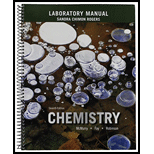
Concept explainers
(b)
Interpretation:
The valence bond description of the bonding in
Concept introduction:
- In
valence bond theory , the donation of pairs of electrons by ligands to the central metal atom or ion results in the metal-ligand bond. - The metal ion possesses a requisite number of valence orbitals of almost equal energy in order to accommodate the electrons given by ligands.
- The unpaired (n-1) d electrons, pair up as fully as possible prior to hybridization thus making some (n-1) d orbitals vacant. The central metal atom then makes available the number of empty orbitals equal to its coordination number for the formation of coordinate bonds with suitable ligand orbitals.
- With the approach of the ligands, metal-ligand bonds are then formed by the overlap of these orbitals with those of the ligands, that is by donation of electron pairs by the ligands to the empty hybridized orbitals.
(c)
Interpretation:
The valence bond description of the bonding in
Concept introduction:
- In valence bond theory, the donation of pairs of electrons by ligands to the central metal atom or ion results in the metal-ligand bond.
- The metal ion possesses a requisite number of valence orbitals of almost equal energy in order to accommodate the electrons given by ligands.
- The unpaired (n-1) d electrons, pair up as fully as possible prior to hybridization thus making some (n-1) d orbitals vacant. The central metal atom then makes available the number of empty orbitals equal to its coordination number for the formation of coordinate bonds with suitable ligand orbitals.
- With the approach of the ligands, metal-ligand bonds are then formed by the overlap of these orbitals with those of the ligands, that is by donation of electron pairs by the ligands to the empty hybridized orbitals.
(d)
Interpretation:
The valence bond description of the bonding in
Concept introduction:
- In valence bond theory, the donation of pairs of electrons by ligands to the central metal atom or ion results in the metal-ligand bond.
- The metal ion possesses a requisite number of valence orbitals of almost equal energy in order to accommodate the electrons given by ligands.
- The unpaired (n-1) d electrons, pair up as fully as possible prior to hybridization thus making some (n-1) d orbitals vacant. The central metal atom then makes available the number of empty orbitals equal to its coordination number for the formation of coordinate bonds with suitable ligand orbitals.
- With the approach of the ligands, metal-ligand bonds are then formed by the overlap of these orbitals with those of the ligands, that is by donation of electron pairs by the ligands to the empty hybridized orbitals.
Want to see the full answer?
Check out a sample textbook solution
Chapter 20 Solutions
Laboratory Manual for Chemistry (7th Edition)
 ChemistryChemistryISBN:9781305957404Author:Steven S. Zumdahl, Susan A. Zumdahl, Donald J. DeCostePublisher:Cengage Learning
ChemistryChemistryISBN:9781305957404Author:Steven S. Zumdahl, Susan A. Zumdahl, Donald J. DeCostePublisher:Cengage Learning ChemistryChemistryISBN:9781259911156Author:Raymond Chang Dr., Jason Overby ProfessorPublisher:McGraw-Hill Education
ChemistryChemistryISBN:9781259911156Author:Raymond Chang Dr., Jason Overby ProfessorPublisher:McGraw-Hill Education Principles of Instrumental AnalysisChemistryISBN:9781305577213Author:Douglas A. Skoog, F. James Holler, Stanley R. CrouchPublisher:Cengage Learning
Principles of Instrumental AnalysisChemistryISBN:9781305577213Author:Douglas A. Skoog, F. James Holler, Stanley R. CrouchPublisher:Cengage Learning Organic ChemistryChemistryISBN:9780078021558Author:Janice Gorzynski Smith Dr.Publisher:McGraw-Hill Education
Organic ChemistryChemistryISBN:9780078021558Author:Janice Gorzynski Smith Dr.Publisher:McGraw-Hill Education Chemistry: Principles and ReactionsChemistryISBN:9781305079373Author:William L. Masterton, Cecile N. HurleyPublisher:Cengage Learning
Chemistry: Principles and ReactionsChemistryISBN:9781305079373Author:William L. Masterton, Cecile N. HurleyPublisher:Cengage Learning Elementary Principles of Chemical Processes, Bind...ChemistryISBN:9781118431221Author:Richard M. Felder, Ronald W. Rousseau, Lisa G. BullardPublisher:WILEY
Elementary Principles of Chemical Processes, Bind...ChemistryISBN:9781118431221Author:Richard M. Felder, Ronald W. Rousseau, Lisa G. BullardPublisher:WILEY





